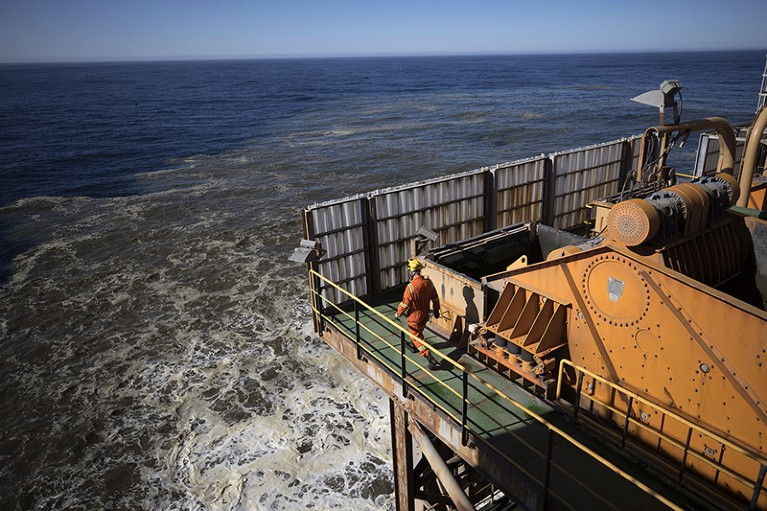
Companies are eyeing riches on the seabed but at what environmental cost?Credit: Simon Dawson/Bloomberg/Getty
The biggest deep-sea mining operation so far was a cold-war ruse. In 1974, the US Central Intelligence Agency launched an elaborate operation to recover a Soviet submarine northwest of Hawaii, under the cover of a commercial venture to mine manganese nodules located on the sea floor. The spooks got a piece of the submarine but left any valuable minerals in the area for future prospectors.
Despite mounting interest in such sea-bed resources, little has happened since. But the world’s first commercial mining venture in the deep sea seems only a matter of time. Estimates vary, but optimists claim there could be huge untapped piles of precious metals, including gold and silver, down there. Several countries, including Papua New Guinea, Japan and South Korea, are pursuing sea-bed mining in their territorial waters, and interest in international waters is on the rise, as well. The International Seabed Authority (ISA), which was established in 1994 under the United Nations’ Law of the Sea and regulates activities that occur outside national jurisdictions, has already issued 28 exploration permits to entities in 20 countries.
At a meeting next week, the ISA’s council will once again discuss a possible process to permit, monitor and end mining operations, which will eventually cover more than half of the ocean floor — collectively known as ‘the Area’. The ISA began deliberations in earnest in January 2017, and observers think that the regulations could be formalized as early as 2020. Many of the details must still be ironed out.
The impact of the regulations will necessarily be limited: 29 countries, including the United States, have yet to either sign or ratify the Law of the Sea, and so are not technically bound by the ISA’s authority. And within national waters, each country must craft sensible regulations. But the ISA could help to create best-practice policy that will aid governments in regulating domestic activities.
For a time, it looked as if the first commercial project could be in Papua New Guinea, where the Canadian firm Nautilus received its first lease in 2011. The site is located at a depth of 1,600 metres in the Bismarck Sea, between the islands of New Britain and New Ireland, but the company’s quest for copper and gold deposits has encountered numerous legal and economic challenges. It remains unclear when or whether operations will move forward.
The slow pace of development has given a little breathing room to scientists who are scrambling to understand the impacts of sea-bed mining. Already, researchers have raised a host of potential problems. The most obvious is that scouring the ocean floor will destroy a landscape — and an ecosystem — that is unlikely to recover quickly: after all, it took millions of years for these mineral deposits to form.
But the impacts could stretch well beyond the immediate mining area. The dredging and collection process create underwater plumes of particles, and any material left over after the initial processing on ships could be released back into the ocean. That material will spread and eventually sink, potentially affecting life at all ocean depths.
The ISA’s priority now must be to create strong environmental safeguards. In particular, regional environmental management plans must be put in place before any mining occurs. This is where research comes in: experts must determine how much of the ocean floor should be set aside, and where, to preserve biodiversity. And it can help to explain how dense particle plumes can become, and how far they should be allowed to spread. Researchers worldwide are investigating these issues.
Governments must look at mining and minerals holistically. Where possible, the goal must be to reduce consumption and increase recycling, through more-systematic recovery efforts and better product designs. But demand for metals is unlikely to abate soon. And mining on land comes with its own environmental impacts. It could even be that venturing into the sea — if done properly, and with the correct safeguards — makes more sense than digging yet another ugly hole in a sensitive terrestrial environment. But we can’t say so yet.

 Ocean circulation is changing, and we need to know why
Ocean circulation is changing, and we need to know why
 Ocean-wide sensor array provides new look at global ocean current
Ocean-wide sensor array provides new look at global ocean current
 Mineral supply for sustainable development requires resource governance
Mineral supply for sustainable development requires resource governance



